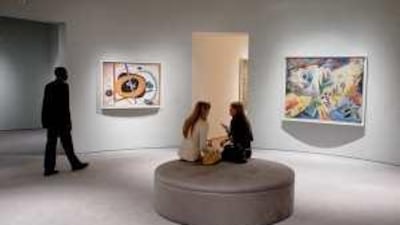ABU DHABI// For the first time since Abu Dhabi announced it would have its own Guggenheim Museum, audiences in the capital can get an idea of the kind of art to be displayed there. The Guggenheim: The Making of a Museum, an exhibition hosted by the Tourism Development & Investment Company (TDIC) at the Emirates Palace opened last night with a selection of 50 of the most important paintings from the Guggenheim New York collection. Taking the viewer on a journey from the impressionist works of late 19th century from Paul Cezanne and Henri Matisse through to the post-war abstract paintings from Jackson Pollock and Mark Rothko and beyond to the mid-1960s, the show is intended to to tell the story of how the original museum was founded. "It is a taste of things to come," said Valerie Hillings, one of the two curators. "The first Guggenheim museum started with the idea to build a collection of contemporary art and this show is a snapshot of that history." Although these are not the exact pieces destined to be displayed at the new premises due to open in four years as part of Abu Dhabi's new cultural district on Saadiyat Island, Richard Armstrong, the director of the Solomon R. Guggenheim Foundation and the Guggenheim Musuem in New York said it would be a good opportunity to train the audience's eyes. Among the pieces on show is one where, to the untrained eye, the splashes of green, silver, black, red and yellow splattered across the canvas might appear to be the result of an unsupervised painting session at the local playschool. In fact, Untitled (Green Silver), by the late abstract expressionist artist Jackson Pollock, is one of the most important works of art yet displayed in the capital. The 1949 "action painting" was created by Pollock flinging, dripping, pouring and spattering enamel and aluminium paint on to a canvas laid on the floor. A similar painting, Number 12, from the same year, sold for US$11.65 million (Dh42.81m) in 2004 in New York. Canvases such as Cézanne's Bend in the Road Through the Forest and Matisse's Nude in a Forest, which open the exhibition, illustrate the seeds of abstract painting. "The loose brush strokes force the eye to blend colour," said Ms Hillings. "It is perhaps the beginning of optical illusions in art." A circular room, at the centre of the exhibition, with soft, grey carpeting and a round sofa, was intended to be a "spiritual temple to art", said Ms Davidson. Works by Rudolf Bauer, Wassily Kandinsky and Hilla Rebay, artists who tried to "evoke the spiritual and human emotions in an increasingly secular world", are on display there. The final room, a long, light space with wooden floors, holds many large-scale, post-war paintings that Ms Davidson said represented "the anxiety of artists learning to live with the threat of nuclear bombs through the Cold War". "We have to admit that the eye is a muscle and the more it is used, the stronger it gets. We are aware that not everyone in the [Abu Dhabi] audience has a long history of looking at this type of art so we want to introduce them gently." This was the first in a series of exhibitions organised by the Guggenheim Foundation in the run-up to the opening of the museum in Abu Dhabi in 2013. Mubarak al Muhairi, the managing director of the TDIC, said the exhibition was a milestone for the city. "[It] represents a new achievement in Abu Dhabi's cultural programme, in which we are constantly striving to bring the arts into the daily lives and thoughts of our people," he said. The TDIC has also scheduled a programme of monthly workshops and lectures to run alongside the exhibition, which is on until February 4. There will be a lecture on the early history of the Guggenheim Museum from Karole Vail, a curator at the museum in New York, a panel discussion about the role of the museum today and lectures on abstract art from international experts. Rita Aoun-Abdo, the director of culture at the TDIC, said the programme was intended to be educational. "We want to engage people of every age and every background into active dialogue," she said. "Education has always been very important to us." Mr Armstrong said he hoped, in time, the people of Abu Dhabi would come to feel as though they owned something of the museum. "We want people to grow up with it and feel so at home that it is partly theirs. Art unlocks a capacity to dream and see beauty and, ultimately, that's how we want people to feel in the Guggenheim Abu Dhabi." aseaman@thenational.ae

Glimpse inside the Guggenheim
An exhibition of 50 of the most important paintings from the Guggenheim New York collection opened last night in Abu Dhabi.
Most popular today
